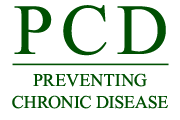PCD News Summary for September 21, 2017

Notice to News Media – PCD Release Time and Embargo Policy:
CDC’s News Media Branch releases to reporters the PCD media packet every Tuesday afternoon between 12 and 2 pm.
Embargoed until Thursday, September 21, at 12:00 PM ET
Longitudinal Analysis of Nut-Inclusive Diets and Body Mass Index Among Overweight and Obese African American Women Living in Rural Alabama and Mississippi, 2011–2013
African American women in rural Alabama and Mississippi who included nuts in their diet were more likely to also eat other nutritionally rich foods and have a lower body mass index. Researchers monitored changes in nut intake, other obesity-related foods (fruits, vegetables, red or processed meats, added sugars), and body mass index (BMI) over a two-year weight loss intervention among 383 overweight and obese African American women in rural Alabama and Mississippi. The study found that, overall, nut consumers ate more fruits and vegetables and less red meat than non-nut consumers and had lower BMI values than non-nut consumers. Weight loss by the end of the intervention was significant for nut consumers but not for non-nut consumers, even after accounting for calorie consumption and physical activity.
Melissa Newton
mnewton@cdc.gov
404-718-6281
Could EBT Machines Increase Fruit and Vegetable Purchases at New York City Green Carts?
Expanding access to electronic benefit transfer (EBT) machines at New York mobile produce carts may increase purchases of fruits and vegetables. Residents of some low-income neighborhoods often have limited access to fresh fruits and vegetables. In 2008, in an effort to address this shortfall, New York City issued new mobile fruit and vegetable cart licenses for neighborhoods with inadequate availability of fresh produce. Some of these carts were equipped with EBT, allowing them to accept Supplemental Nutrition Assistance Program (SNAP) benefits. A total of 779 adults participated in this survey of customers at four produce carts in Bronx, New York, in 2013 and 2014. Researchers found that shoppers who used SNAP benefits bought an average of nearly five and a half more cups of fruits and vegetables than shoppers who paid with cash. Approximately 80 percent of this difference was from higher quantities of purchased fruits.
Melissa Newton
mnewton@cdc.gov
404-718-6281
###
Note: Not all articles published in PCD represent work done at CDC. In your stories, please clarify whether a study was conducted by CDC (“a CDC study”) or by another institution (“a study published by CDC”). The opinions expressed by authors contributing to PCD do not necessarily reflect the opinions of CDC or the institutions with which the authors are affiliated. PCD requests that, when possible, you include a live link to the article in your stories.
###
U.S. DEPARTMENT OF HEALTH AND HUMAN SERVICES
CDC works 24/7 protecting America’s health, safety and security. Whether diseases start at home or abroad, are curable or preventable, chronic or acute, stem from human error or deliberate attack, CDC is committed to respond to America’s most pressing health challenges.
- Page last reviewed: September 21, 2017
- Page last updated: September 21, 2017
- Content source:



 ShareCompartir
ShareCompartir